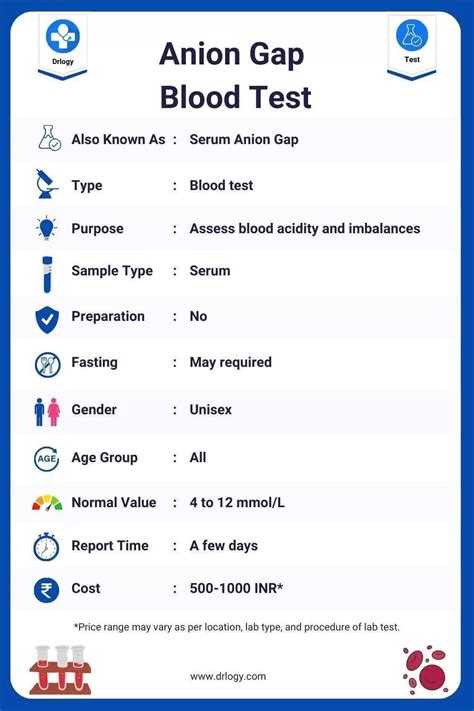Intro
Learn about the Anion Gap Blood Test, a crucial diagnostic tool measuring electrolyte balance. Discover how it helps diagnose acid-base disorders, kidney disease, and other conditions. Understand the normal range, causes of high or low anion gaps, and what your results mean for your health. Get informed about this vital medical test.
The anion gap blood test is a crucial diagnostic tool that helps healthcare professionals identify various underlying medical conditions. This test measures the difference between the levels of positively charged ions (cations) and negatively charged ions (anions) in the blood. In this article, we will delve into the world of anion gap blood tests, exploring what they are, how they work, and what the results mean.

The anion gap blood test is often used to diagnose and monitor conditions such as metabolic acidosis, kidney disease, and electrolyte imbalances. It can also help healthcare professionals identify the underlying cause of symptoms such as fatigue, weakness, and shortness of breath. In this article, we will discuss the benefits, working mechanisms, and steps involved in an anion gap blood test, as well as provide practical examples and statistical data to enhance understanding.
What is an Anion Gap Blood Test?
An anion gap blood test is a type of electrolyte panel that measures the levels of various ions in the blood, including sodium, potassium, chloride, and bicarbonate. The test calculates the difference between the levels of cations (sodium and potassium) and anions (chloride and bicarbonate) to determine the anion gap.
How Does an Anion Gap Blood Test Work?
The anion gap blood test works by measuring the levels of various ions in the blood using a process called flame photometry. This process involves heating the blood sample to high temperatures, causing the ions to emit light. The intensity of the light emitted is directly proportional to the concentration of the ions.
The anion gap is calculated using the following formula:
Anion Gap = (Sodium + Potassium) - (Chloride + Bicarbonate)
A normal anion gap ranges from 8 to 12 mmol/L. An elevated anion gap indicates the presence of an underlying medical condition.
What are the Benefits of an Anion Gap Blood Test?
An anion gap blood test offers several benefits, including:
- Early diagnosis: An anion gap blood test can help diagnose underlying medical conditions, such as metabolic acidosis, kidney disease, and electrolyte imbalances, at an early stage.
- Monitoring treatment: The test can be used to monitor the effectiveness of treatment and adjust medication as needed.
- Preventing complications: An anion gap blood test can help identify potential complications, such as respiratory failure, and prevent them from occurring.

What are the Steps Involved in an Anion Gap Blood Test?
The steps involved in an anion gap blood test are as follows:
- Blood sample collection: A healthcare professional will collect a blood sample from a vein in your arm using a needle and syringe.
- Labeling and storage: The blood sample will be labeled and stored in a refrigerated environment until it is sent to the laboratory for analysis.
- Analysis: The blood sample will be analyzed using flame photometry to measure the levels of various ions.
- Calculation: The anion gap will be calculated using the formula above.
What Do the Results Mean?
The results of an anion gap blood test can indicate the presence of an underlying medical condition. A normal anion gap ranges from 8 to 12 mmol/L. An elevated anion gap can indicate conditions such as metabolic acidosis, kidney disease, and electrolyte imbalances.
Here are some examples of anion gap results and their corresponding conditions:
- Normal anion gap: 8-12 mmol/L (normal)
- Elevated anion gap: 13-15 mmol/L (mild metabolic acidosis)
- High anion gap: 16-20 mmol/L (moderate metabolic acidosis)
- Very high anion gap: >20 mmol/L (severe metabolic acidosis)

What are the Limitations of an Anion Gap Blood Test?
While an anion gap blood test is a valuable diagnostic tool, it has some limitations. These include:
- Inaccurate results: The test results can be affected by various factors, such as medication, diet, and underlying medical conditions.
- Limited sensitivity: The test may not detect mild metabolic acidosis or other conditions.
- Requires additional testing: An anion gap blood test may require additional testing, such as a complete blood count (CBC) or a comprehensive metabolic panel (CMP), to confirm the diagnosis.
What are the Risks and Complications of an Anion Gap Blood Test?
An anion gap blood test is generally a safe procedure. However, as with any medical test, there are some risks and complications to be aware of. These include:
- Bleeding: Bleeding may occur at the site of the blood sample collection.
- Infection: Infection may occur at the site of the blood sample collection.
- Allergic reaction: An allergic reaction may occur to the antiseptic or other materials used during the test.

Conclusion
An anion gap blood test is a valuable diagnostic tool that helps healthcare professionals identify underlying medical conditions. By understanding the benefits, working mechanisms, and steps involved in an anion gap blood test, you can take an active role in your healthcare. If you have any questions or concerns, be sure to discuss them with your healthcare professional.

We hope this article has provided you with a comprehensive understanding of anion gap blood tests. If you have any further questions or concerns, please don't hesitate to reach out to us.
Share your thoughts: Have you ever had an anion gap blood test? What was your experience like? Share your thoughts and experiences in the comments below.
Share this article: Share this article with your friends and family to help them understand the importance of anion gap blood tests.
What is an anion gap blood test?
+An anion gap blood test is a type of electrolyte panel that measures the levels of various ions in the blood, including sodium, potassium, chloride, and bicarbonate.
What is the normal range for an anion gap?
+A normal anion gap ranges from 8 to 12 mmol/L.
What are the risks and complications of an anion gap blood test?
+The risks and complications of an anion gap blood test include bleeding, infection, and allergic reaction.
